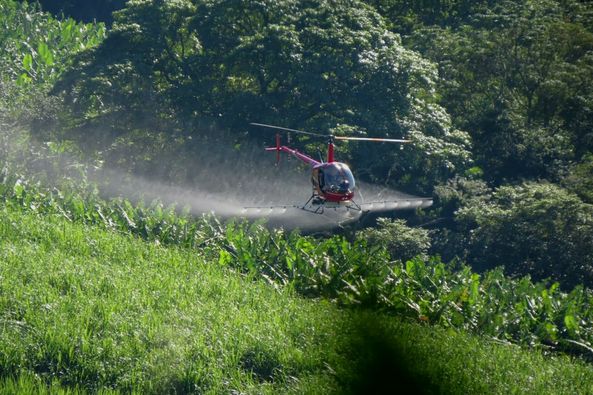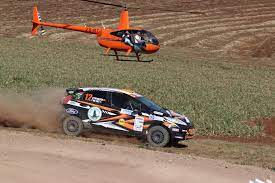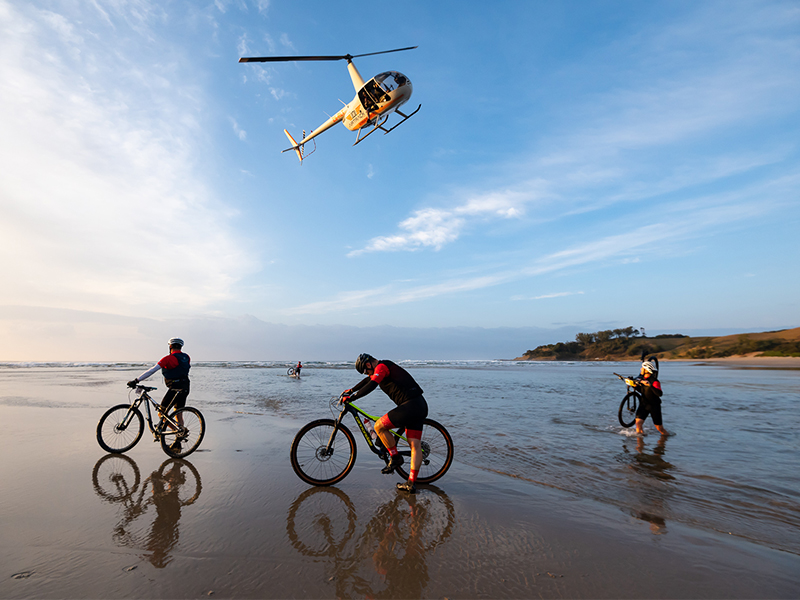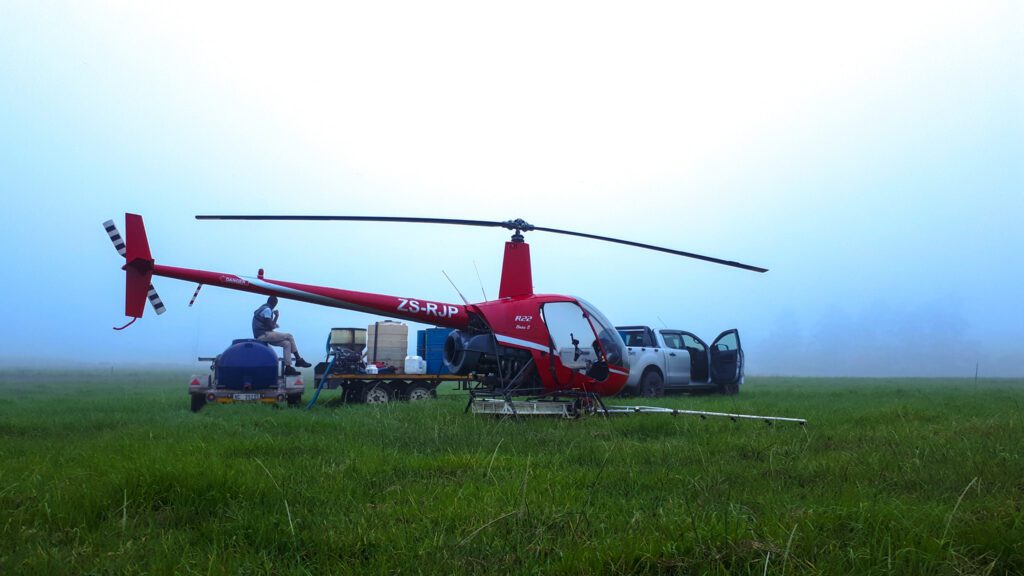Crop Spraying
Triple R Aviation Aerial Applications

Triple R Aviation Crop Spraying was established in 2013, as the best KZN crop spraying service company.
Our satellite base operates out of Dalton east of New Hanover and south of Greytown in the uMshwati Local Municipality of KwaZulu-Natal, South Africa. A thank you to our committed team who support the local farmers in the area in crop spraying applications.
Triple R Aviation specializes in aerial applications. We are aerial applicators that utilize helicopters, All our pilots have in excess of 3000 hours of Spraying flight time, and crew members are knowledgeable in agriculture and aviation. We test and calibrate regularly, and using a helicopter provides highly effective and precise application of crop protection products. We have both standard hydraulic nozzles as well as rotary atomizers. We work with farmers to choose the best droplet size and application rate to meet their specific needs.
Our Helicopters can reload off a ground trailer positioned on-site directly beside the field. This increases spraying time and productivity.
Fixed-wing aircraft generally carry larger loads and can travel at higher speeds covering acres very quickly but they must fly to a landing strip to reload, increasing ferry time.
Application with a helicopter may be an advantage if you live greater than 20km from a landing strip.
Helicopters have an advantage in small, confined, irregular fields with obstacles such as trees or sloughs. The slower travel speed allows a high level of accuracy, the tighter turning radius helps make up for the travel speed.
At slower speeds, the helicopter’s rotor wash, which occurs when the rotor blades push the chemicals downwards towards the ground, can help spread the chemicals on the underside of the plants where bugs, fungus, etc. are located. This can be of advantage when treating larger treed areas.
At higher speeds, the large separation between the rotor and the spray boom means the spray remains undisturbed before entering the canopy causing a uniform spray pattern with less chance of drift.
When choosing whether the time is right for an application, the helicopter can be on-site monitoring temp, wind, dew, etc so there is no guesswork.
What do planes spray on crops?
Planes, specifically aerial applicator planes, spray various substances on crops depending on the specific needs of the farmers. Some common substances that are sprayed on crops include:
- Pesticides: These are used to control pests such as insects, weeds, and diseases that can damage or reduce crop yields.
Herbicides: These are chemicals used to control weeds that compete with crops for nutrients, water, and sunlight.
- Fungicides: These are substances that help control fungal diseases which can damage crops, such as powdery mildew or rust.
- Insecticides: These are chemicals used to eliminate or reduce insect populations that can cause significant damage to crops.
- Fertilizers: While not technically “sprayed,” planes can also distribute fertilizers over crops to provide essential nutrients that promote healthy growth and increase yields.
It’s important to note that the choice and use of these substances should be done carefully and in accordance with local regulations and best agricultural practices to ensure the safety of the environment, consumers, and workers involved in crop production. Triple R Aviation adheres to all regulations and offers a professional service to their clients
Why do Farmers Spray Their Fields?
Farming is a challenging and demanding profession that requires careful attention to detail and the ability to adapt to ever-changing conditions. One crucial aspect of modern agriculture is crop spraying, which involves the application of various substances to the fields. But why do farmers spray their fields? Let’s explore some motivating reasons:
1. Crop Protection
One of the primary reasons farmers spray their fields is to protect their crops from pests, diseases, and weeds. Insects, such as aphids and caterpillars, can wreak havoc on crops, causing significant damage and reducing yields. By using pesticides and insecticides, farmers can effectively control these pests and safeguard their harvests. Additionally, spraying fields with fungicides helps combat fungal diseases that can devastate crops and compromise their quality.
2. Weed Control
Weeds are persistent competitors that compete with crops for vital resources like nutrients, water, and sunlight. If left uncontrolled, weeds can hinder crop growth and significantly reduce yields. Farmers use herbicides to suppress or eliminate weeds, ensuring that their crops have the best chance to thrive and reach their full potential.
3. Disease Prevention
Plant diseases can spread rapidly and have detrimental effects on entire crop populations. To prevent the outbreak and spread of diseases, farmers spray fungicides on their fields. By protecting their crops from diseases like powdery mildew or rust, farmers can help maintain healthy plants and maximize their harvests.
4. Increased Productivity
Spraying fields can significantly improve overall productivity in agriculture. It allows farmers to address multiple challenges simultaneously, reducing potential crop losses and ensuring a robust harvest. By protecting crops from pests and diseases, farmers can optimize their yields, contributing to increased food production and food security.
5. Precision and Efficiency
Spraying fields with modern techniques and equipment enables farmers to apply substances precisely and efficiently. Advanced spraying technologies ensure that the right amount of each substance is deployed with minimal waste. This precision helps farmers achieve uniform coverage, reduce the risk of environmental contamination, and optimize the effectiveness of crop protection measures.
Conclusion
Farmers spray their fields to protect crops, control pests and weeds, prevent diseases, and maximize productivity. Through careful application of substances, farmers can ensure healthy crops, higher yields,
Crop dusting, also known as aerial application, plays a crucial role in modern agriculture by efficiently and effectively delivering substances to crops. The substances sprayed during crop dusting can vary based on the specific needs of the farmers and the crops being cultivated. Let’s explore some of the common substances used in crop dusting:
The Difference Between Crop Dusting and Aerial Spraying
Crop dusting and aerial spraying are two distinct methods used in agriculture to apply substances to crops. While they both involve the use of aircraft, there are key differences between the two techniques. Let’s take a closer look at each method:
Crop Dusting
Crop dusting, also known as aerial application, refers to the process of applying substances such as pesticides, herbicides, and fertilizers to crops using a specialized aircraft. Traditionally, small planes or helicopters equipped with spraying equipment are utilized for crop dusting.
- Targeted Applications: Crop dusting is often used for precise, targeted applications. Pilots carefully maneuver the aircraft to deliver the substances directly to the crops, minimizing the risk of overspray or drift. This precision allows for effective pest and weed control without impacting neighboring fields or the environment.
- Flexibility: Crop dusters, typically fixed-wing aircraft or helicopters, offer greater flexibility in terms of maneuverability and speed. They can access areas that are challenging or impossible for ground-based equipment to reach, such as uneven or sloped terrain, dense rows of crops, or remote fields.
- Suitable for Small Fields: Crop dusting is particularly advantageous for small to medium-sized fields with irregular shapes or obstacles. The ability to navigate around trees, power lines, or buildings allows for accurate application in confined spaces.
- Individual Plant Treatment: Crop dusters excel at providing individual plant treatment when necessary. The pilot can carefully adjust the flight path and spraying equipment to target specific plants within a field, minimizing the use of chemicals and optimizing crop health.
Aerial Spraying
Aerial spraying, on the other hand, refers to the broader practice of using aircraft to distribute substances over large areas of crops. The aircraft used for aerial spraying are typically larger and carry a higher payload than crop dusters, allowing for more extensive coverage in a shorter period.
- High-Speed Coverage: Aerial spraying is known for its efficiency in covering large areas quickly. The speed and larger payload capacity of the aircraft enable spraying over vast fields with fewer refill stops, enhancing productivity.
- Landing Strip Dependency: Unlike crop dusters that can reload directly on-site, aerial spraying aircraft often rely on landing strips or designated refill areas. This necessitates additional flight time for reloading, which may not be as cost effctive.
Our experienced pilots and knowledgeable crew members ensure that all aerial spraying operations are conducted with utmost precision and efficiency. With over 20000 hours of spraying flight time, our pilots have the expertise and skill to deliver highly effective and precise applications of crop protection products. We regularly test and calibrate our equipment to ensure optimal performance.
One of the advantages of using helicopters for crop spraying is the ability to reload directly off a ground trailer positioned on-site, right beside the field. This eliminates the need to fly to a landing strip for reloading, saving time and increasing productivity. This feature is especially beneficial for farmers who live in areas that are more than 20km away from a landing strip.
Helicopters offer a significant advantage in small, confined, and irregularly shaped fields with obstacles such as trees or sloughs. Their slower travel speeds allow for a high level of accuracy, and their tighter turning radius helps compensate for the reduced speed.
When flying at lower speeds, the helicopter’s rotor wash helps spread the chemicals on the underside of the plants where pests, fungi, and other threats are often located. This can be particularly advantageous when treating larger treed areas.
On the other hand, at higher speeds, the larger separation between the rotor and the spray boom ensures that the spray remains undisturbed before entering the canopy. This results in a more uniform spray pattern with less chance of drift, increasing the overall effectiveness of the application.
Additionally, helicopters can provide real-time monitoring of environmental factors such as temperature, wind, and dew while on-site. This eliminates the guesswork involved in determining the right time for an application, ensuring optimal conditions for maximum effectiveness.
In summary, Triple R Aviation’s aerial spraying services offer precise and efficient crop protection solutions. Our helicopters, experienced pilots, and knowledgeable crew members enable us to deliver highly effective applications, even in challenging terrains. From small, irregular fields to larger treed areas, our spraying operations are tailored to meet the specific needs of each farmer. Choose Triple R Aviation for professional crop spraying services that guarantee effective and environmentally responsible solutions.
Triple R Aviation: Capturing the Thrill of Super Sport Events
Triple R Aviation, known for their exceptional aerial crop spraying services, offers more than just agricultural solutions. They also specialize in capturing the thrill and excitement of super sport events through their high-quality aerial filming services. From rallying events to cycle races, Triple R Aviation has the expertise and equipment to provide stunning aerial footage that showcases the intensity and beauty of these events.
Aerial Filming at Rally Events

Rally events are known for their fast-paced action and challenging terrains. Triple R Aviation’s experienced pilots are skilled at navigating these rugged landscapes, capturing the heart-stopping moments of rally racing from unique angles. With their fleet of Robinson R22 and Robinson R44 helicopters, they can get close to the action, providing breathtaking shots that truly convey the speed and adrenaline of the race.
From the dusty trails of the Imana Wild Ride to the iconic Sani2Sea and Matat2Pont races, Triple R Aviation is there to capture every twist and turn. Their helicopters can maneuver through challenging terrains, allowing them to follow the racers and provide dynamic aerial footage that showcases the sheer excitement of these events.
Aerial Filming at Cycle Races
Cycle races are another popular sporting event that Triple R Aviation specializes in filming. Whether it’s road cycling or mountain biking, their skilled pilots can navigate through the course and capture the energy of these races from a bird’s-eye view. The agility and maneuverability of their helicopters enable them to film cyclists in action, showcasing their speed, endurance, and technical skills.
The Sani2Sea and Matat2Pont races are two iconic cycle events that Triple R Aviation has covered extensively. These multi-stage races take participants through breathtaking landscapes and challenging terrains. Triple R Aviation’s aerial footage adds an extra layer of excitement and drama to these events, providing viewers with a unique perspective of the race and the surrounding scenery.

State-of-the-Art Equipment and Professional Team
Triple R Aviation is committed to delivering exceptional results in their aerial filming services. They utilize state-of-the-art equipment, including stabilized camera systems, to ensure smooth and high-quality footage. Their experienced pilots and crew members have a deep understanding of both aviation and sports, allowing

Or give us a call:
073 999-0999